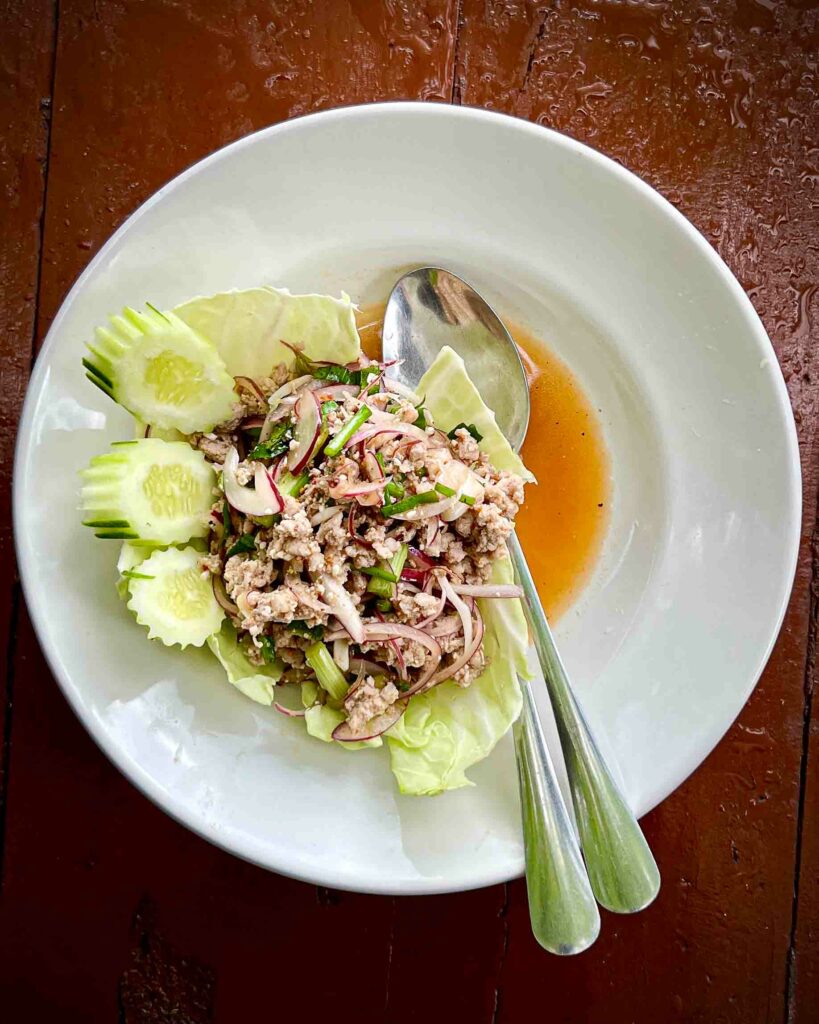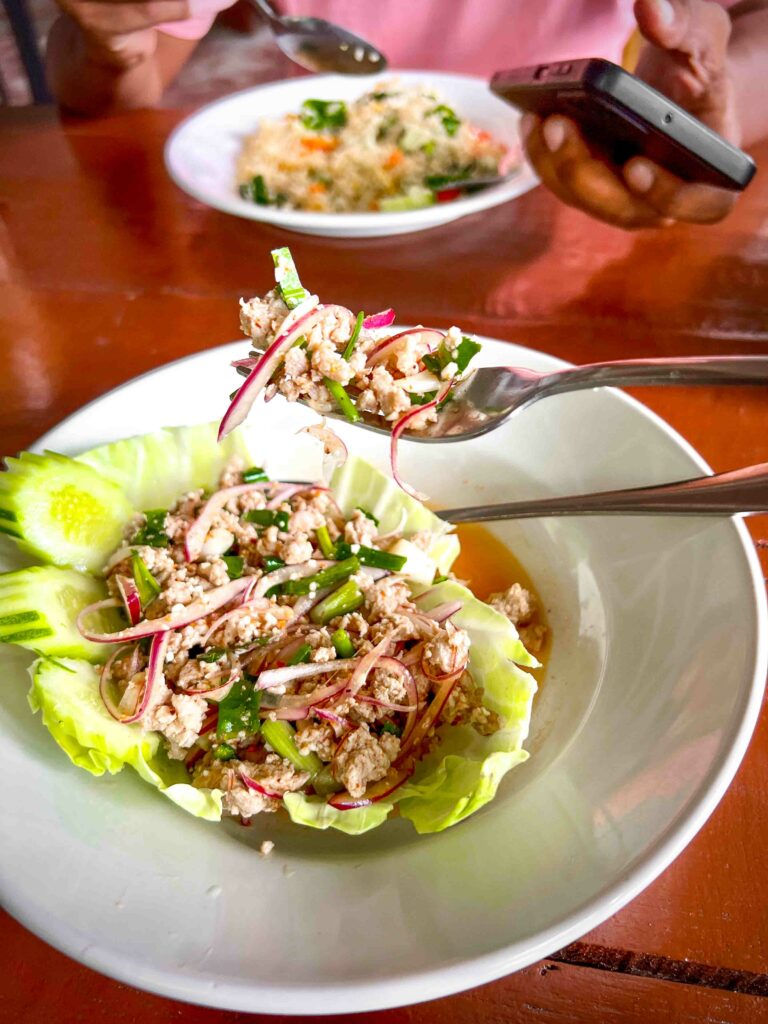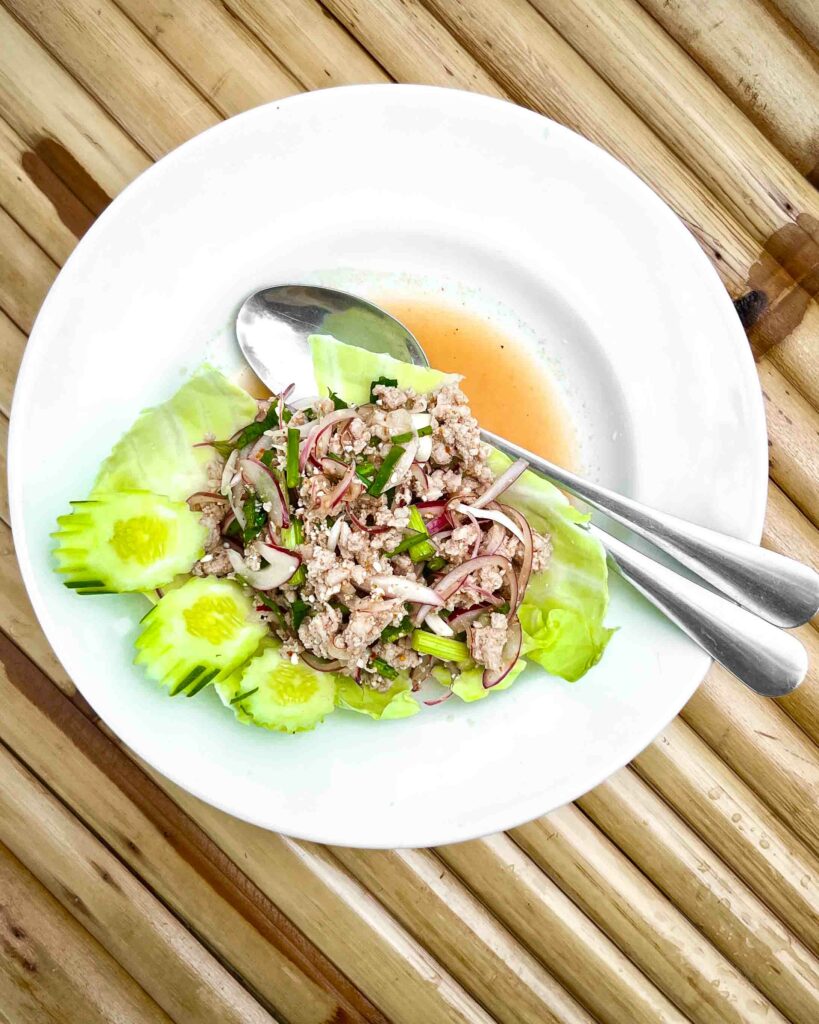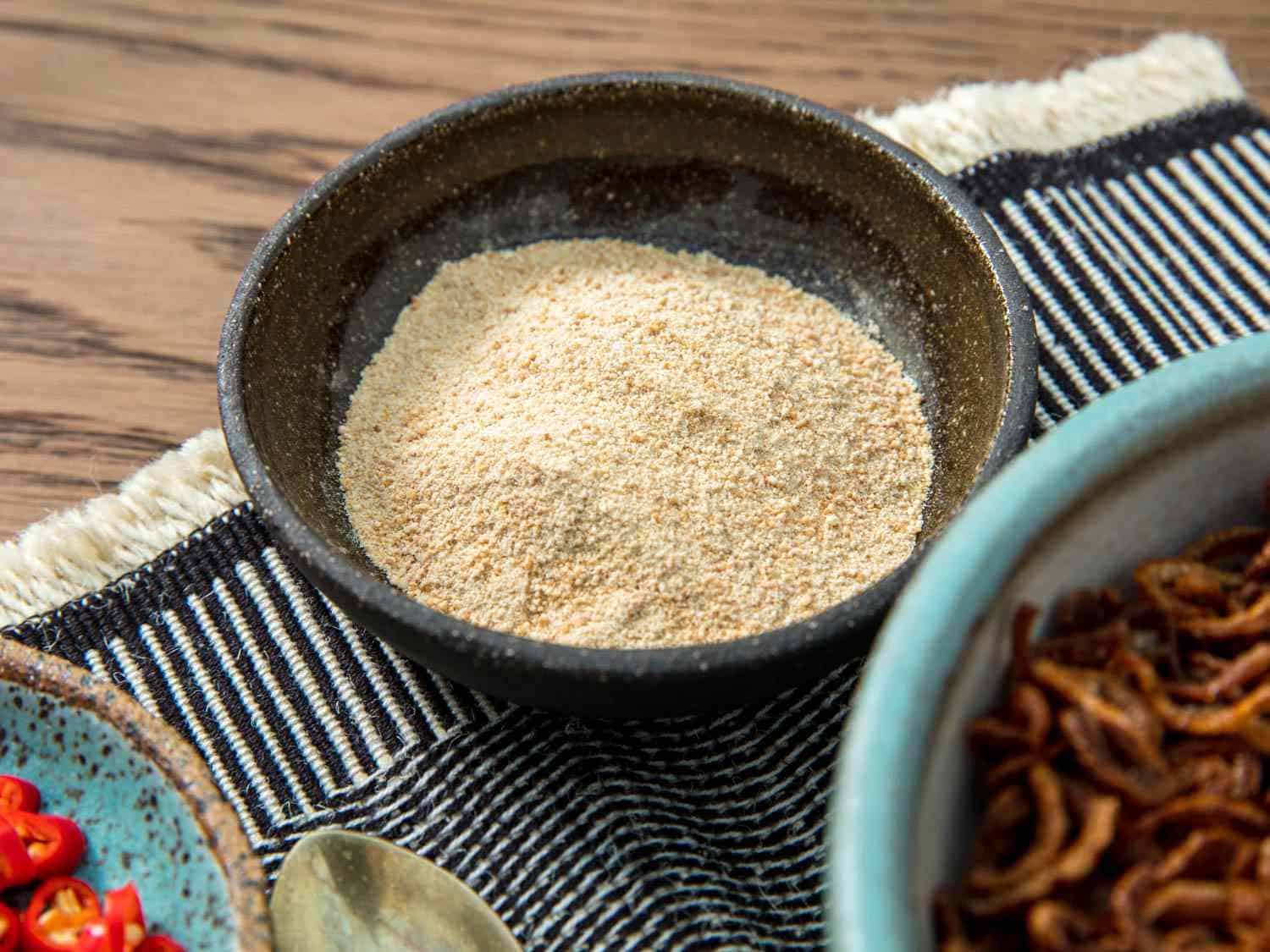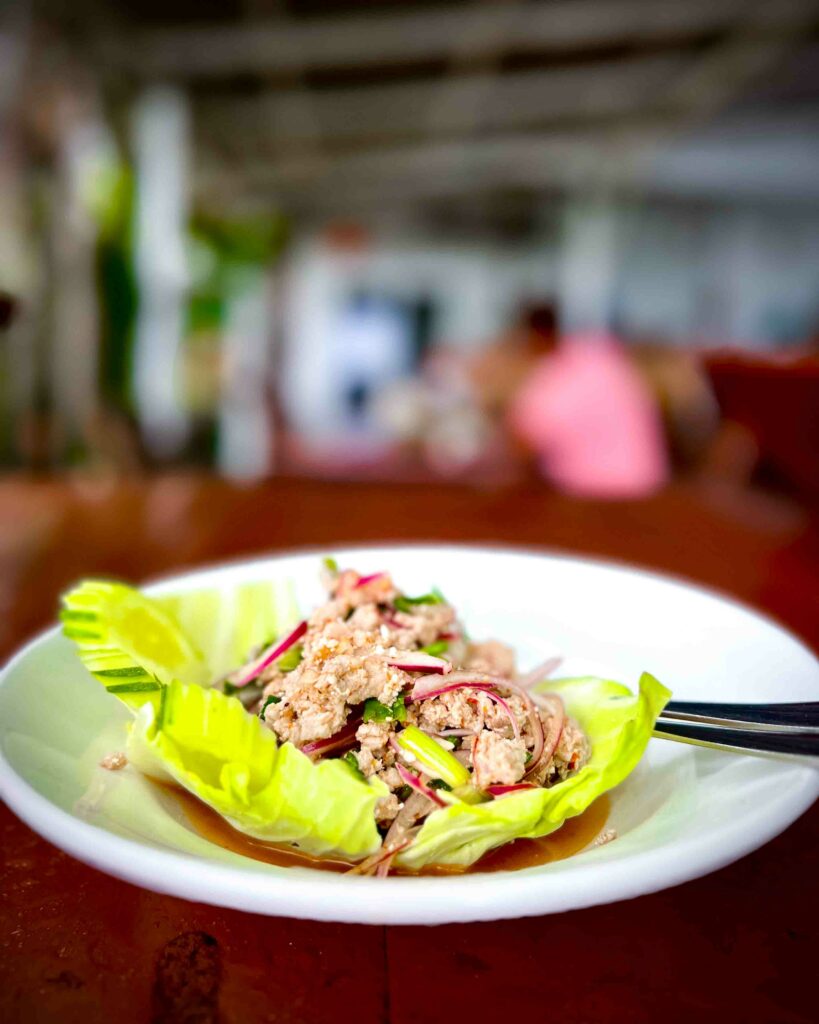Laab moo is a traditional Thai pork salad that is spicy sour and so easy to make!
Laab moo is a delicious and popular Thai food, often recognized for its perfect blend of spicy, sour and umami flavors.
It’s a common food in Chiang Mai, and a traditional food in Chiang Rai. but I first had it in Koh Tao and loved so much I immediately as for the recipe. It has the tart, spicy, sour flavours that are also common in traditional Mexican ceviche.
But this isn’t ceviche, it’s a meat salad. If you like som tum the Thai green papaya salad the ingredients are essentially the same.
As a meat salad, it is primarily made with ground pork, although other proteins can be used as well. Both chicken (laab gai), beef (laab neua) and duck are common variations today.
Not only is this dish known for its unique taste, but it’s also quite healthy, often served with a medley of fresh herbs and crunchy vegetables.
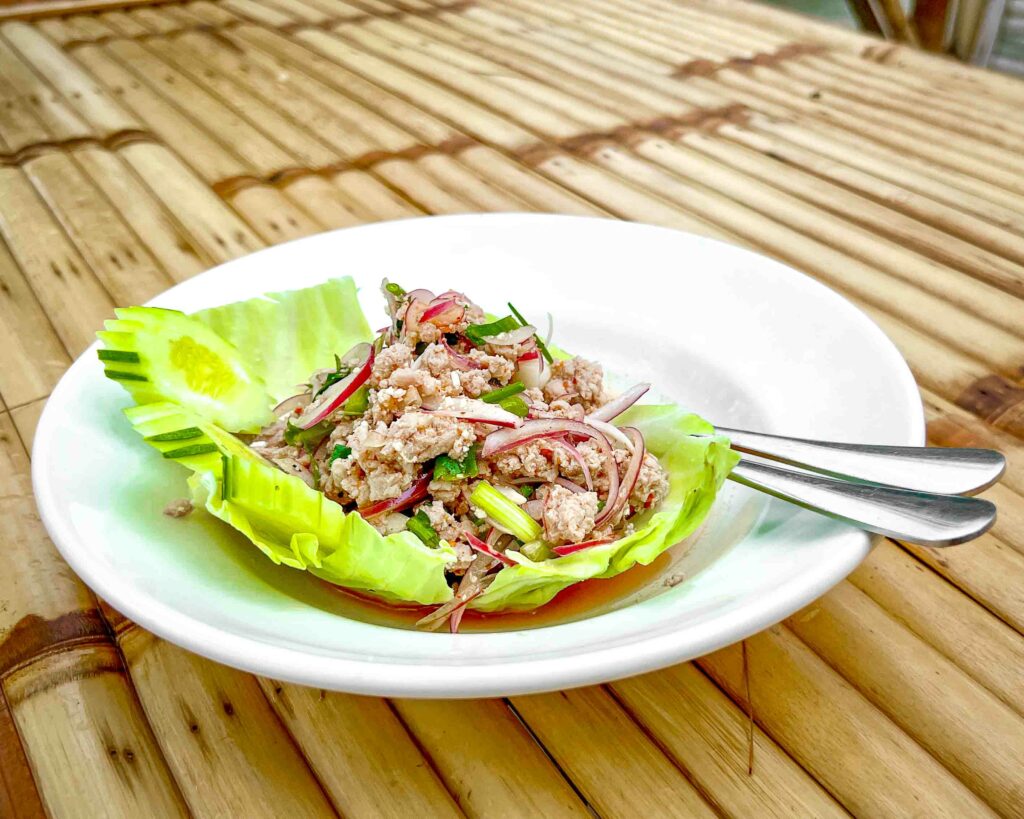
With its roots in the Northeastern region of Thailand known as laab ลาบ, Isan larb moo and also called laab moo, laap moo and lab muu has made its way into the hearts of food lovers all around the world.
If you’re eating this in a Thai restaurant do not pronounce the R in larb moo – it’s laab moo.
Typically served as part of a spread, it is often accompanied by sticky rice, fresh vegetables and various dipping sauces.
Laab moo is quite simple to prepare and can be ready in under 30 minutes.
The combination of fresh ingredients, bold flavors and ease of preparation has made this dish a favorite among Thai food lovers.
As a versatile dish, it can be easily adapted to suit different dietary preferences, such as gluten-free, paleo, low carb and keto diets.
WHERE IS LAAB MOO FROM?
Laab moo is a delicious and popular dish that can be found in both Thailand and Laos.
Although it is considered the national dish of Laos, its origins and influences have expanded beyond the borders of this country, making it a well-loved meal across different regions.
The history between Laos and the northeastern region of Thailand, known as Isan, played a significant role in the spread of laab moo.
Food knows no borders and this close relationship allowed for the dish to journey across the countries and become a staple food in this region of Thailand as well.
The authentic versions of laab, especially those found in northern Thailand and Laos, may include raw meat and blood.
However, the laab moo found in Thai street food stalls and restaurants usually consists of cooked minced pork mixed with spices, herbs and seasonings.
Ayuthhaya Food
What is the Meaning of ‘laab’ in Thai Cuisine?
In the Lao language, the term “laab” translates to “lucky” or as a noun, which shows the significance of this dish in their culture.
In Thailand it refers to a series of dishes where the meat has been finely chopped or ground.
PRIMARY INGREDIENTS OF LAAB MOO
Protein Choices
Laab moo is traditionally made with pork, either minced or ground.
If you prefer, you can also use other protein options such as chicken, minced chicken, duck, or even beef.
Water is added first to prevent the pork from browning and drying out. The key is to bring the meat to room temperature first and cook the meat thoroughly until it’s no longer raw and juices are mostly evaporated.
Herbs and Spices
In laab moo, a combination of fresh herbs and spices is essential to achieve its vibrant flavor.
Culantro is also known as sawtooth coriander and not always easy to find. While I don’t find cilantro tastes like soap I do think culantro does so I leave it out.
If you cannot find it just add cilantro or more mint.
Commonly used herbs include:
- Mint leaves: Fresh mint is the star ingredient in this dish.
- Cilantro: Both the stalk and leaves are roughly chopped and added.
- Green onions or spring onions: Finely sliced for a subtle, slightly sweet onion flavor.
- Culantro: A less common but authentic addition, finely minced.
- Thai sweet basil: Gives a distinct herbal taste, goes well with the spiciness of the dish.
Thai Fruit
For spice, there are several options:
- Chili flakes: Dry ground chili flakes or prik bon adds a nice heat to the recipe. Thai cooks toast their chili flakes first for more flavor.
- Fresh chilies: Finely chopped green or red chilies can be used to adjust the spiciness level to your liking.
Flavor Enhancers
What really brings laab moo together is the balance of different flavors that compliment each other incredibly well. Some of these flavor enhancers are:
- Fish sauce: A pungent and salty liquid that adds umami and depth to the dish.
- Lime or lime juice: Providing acidity and tartness, fresh lime juice is crucial in brightening up the dish.
- Shallots or red onion: Thinly sliced, they give both a mild, sweet onion taste and a vibrant pop of color.
- Sugar: A touch of sugar is added to balance out the acidity and spiciness, but it can be omitted or substituted with healthier options.
The key to a delicious laab moo is to find the right balance of flavors according to your personal taste preferences – saltiness from fish sauce, sourness from lime juice, heat from chilies and sweetness from sugar.
Toasted Rice Powder is Essential
One of its distinct features includes the use of toasted rice powder. Khao khua adds texture, thickens and adds subtle nutty flavor to the dish.
You can either buy it or it’s very easy to make, instructions here.
Don’t Forget the Sticky Rice
A traditional laab moo recipe is served alongside sticky rice.
Sticky rice adds not only a delightful crunch to the salad but also serves a functional purpose in the dish. It effectively absorbs moisture and liquid from the ground meat, enriching the overall taste.
LAAB MOO SUBSTITUTIONS AND VARIATIONS
Below I’m sharing a traditional Thai larb moo recipe; however, I know not everyone can eat it this way.
So here are some suggestions for those with dietary restrictions, allergies and preferences.
Vegetarian Laab Moo
For vegetarians and vegans, mushrooms are an excellent alternative to replace the minced meat. They provide a similar texture and a delicious earthy flavor.
You can experiment with different types of mushrooms, like shiitake, maitake, or cremini, to add variety to the dish.
Low Carb Larb Moo
When it comes to Paleo, Whole30 and low-carb diets, using lean proteins, such as chicken, turkey, or even fish, is a great option.
By pairing those proteins with a variety of vegetables, like cucumbers or green beans, you can create flavorful and nutritious alternatives that suit your dietary restrictions.
ALTERNATIVES TO COMMON INGREDIENTS
I grew up in a small town in Nova Scotia so I know getting international ingredients can be tough.
Here are some modifications to consider:
Soy Sauce Replacement
To make the dish compliant with Whole30, Paleo and soy-free diets, you can swap out soy sauce for coconut aminos – a natural alternative derived from coconut sap.
You’ll still get a rich, flavorful and salty taste without the soy and wheat found in traditional soy sauce.
Oil Modification
If you’re following a keto diet or simply want a healthier fat option, consider replacing vegetable oil with avocado oil.
This will provide a keto-friendly fat source and a neutral flavor that won’t overpower the dish.
Toasted Cashews
Instead of using toasted sticky rice, try toasted cashews for crunchy texture and a slight nutty flavor. This can make your laab moo more suitable for a paleo, keto and low-carb diet.
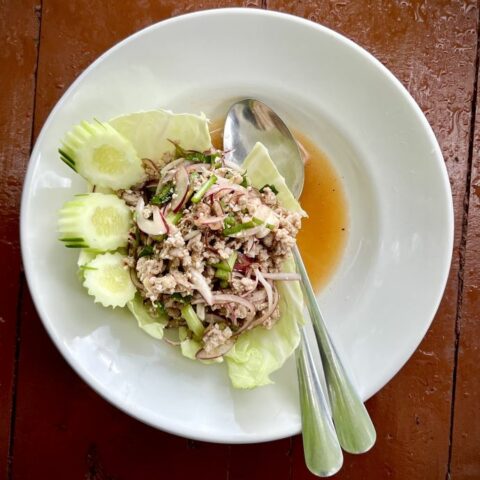
Laab Moo - Thai Pork Salad
Easy 20 minute meat salad, traditional Thai recipe.
Ingredients
- 300g ground pork
- 2 tablespoons water
- 2 tablespoons toasted rice powder (khao khua)
- 2 teaspoons Thai chili flakes, prik bon
- 1/2 teaspoon palm sugar or golden brown sugar
- 3 tablespoons shallots, finely sliced
- 1/4 cup green onion, finely sliced
- 2 tablespoons fresh lime juice
- 1.5 tablespoons fish sauce
- 1/2 tablespoon fresh Thai pepper, thinly sliced (optional)
- 5 culantro leaves (optional)
- 1/4 cup fresh mint leaves
Instructions
- In a heavy bottomed pot or deep pan add water over high heat. Bring to a boil and add pork, cooking until done. Remove from heat.
- To this pot add rice powder, chili flakes, palm sugar and stir. Then add shallots, green onion and fresh Thai pepper (optional).
- Finally add lime juice and fish sauce. Taste and adjust as necessary.
- Bring to room temperature and garnish with mint and culantro just before serving.
Notes
This recipe could be a big salad for 1-2 people. Or serve to 4 people family style with other dishes.
Tasting as you go is necessary! So many of the ingredients can fluctuation is saltiness, spiciness, acidity.
You may need to adjust as you go which is why I left the fish sauce and lime last, try a bit and keep adding to your liking.
FREQUENTLY ASKED QUESTIONS
What are some variations of laab recipes?
There are several variations of laab recipes, which may use different types of minced meat, such as pork, chicken, or beef.
Some recipes might also include sour pork sausage, like in larb som moo, or beef steak, as in larb nam tok.
The choice of protein, herbs and other ingredients can also differ depending on the recipe, region and individual’s personal preferences.
What is the difference between laab moo and laab gai?
Laab Moo is a minced pork salad, whereas laab gai is a meat salad with minced chicken.
Both dishes share a similar base of flavors, including lime, garlic, chili peppers, fish sauce and rice powder.
However, the main difference lies in the choice of protein used.
What type of seasoning is used in laab moo?
Laab moo is seasoned with a combination of ingredients that contribute to its unique blend of spicy, sour, sweet and salty flavors.
These may include lime juice, garlic, chili peppers, fish sauce, palm sugar and toasted rice powder, the latter of which adds a nutty texture to the dish.
Fresh herbs, like cilantro, mint and green onions, are also often used to impart additional aromas and flavors.
What to serve with laab moo?
Laab moo is traditionally served with khao niew, or sticky rice. This complements the flavors and also helps to balance the heat from the chili peppers often found in the dish.
Additionally, laab moo is fantastic with fresh vegetables like cucumbers, cabbage and lettuce leaves, which help to refresh the palate and provide a contrast of textures.
